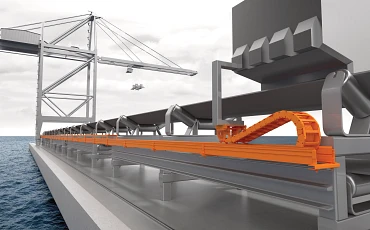At this year’s Hannover Messe, motion plastics specialist igus introduced its latest innovation in cable management systems: the glide-chain G4.42, a lightweight, cost-effective energy chain designed specifically for gliding applications with travel lengths of up to 30 meters—ideal for use in indoor cranes and production hall systems.
Engineered for Efficiency
The new glide-chain G4.42 is built with an emphasis on cost reduction, weight savings, and long service life. By using high-performance plastics only where sliding is necessary, igus has managed to reduce the weight by up to 25% compared to standard chains in its E2 and E4 product ranges.
Its extra-large sliding surfaces and cost-optimized symmetrical side links contribute to a 30–40% cost saving, without compromising durability. The large pitch and simplified component structure further streamline assembly and maintenance.
“In today’s competitive environment, customers are under immense pressure to cut costs,” said Christian Ziegler, Head of Product Management e-chains at igus. “With the G4.42, we’ve developed a solution that combines cost-efficiency and performance with the reliability our customers expect.”
igus also subjected the glide-chain to extensive testing at its 4,000m² in-house test laboratory, validating its performance under real-world conditions. As a mark of confidence, the company offers a four-year guarantee on all energy chains, including the G4.42.
Driving Circular Economy: The “chainge” Recycling Program
As part of its broader commitment to sustainability, igus continues to promote the “chainge” recycling program, which allows customers to return used plastic energy chains—regardless of manufacturer—for eco-friendly recycling.
To date, over 170 tons of plastic have been reclaimed through the program. Returned materials are used to produce new igus components, including the company’s standard E2.1 series, which is now made from recycled plastic.
Participants in the program receive vouchers toward the purchase of new igus products, creating both an environmental and financial incentive to reduce waste and support the circular economy.




